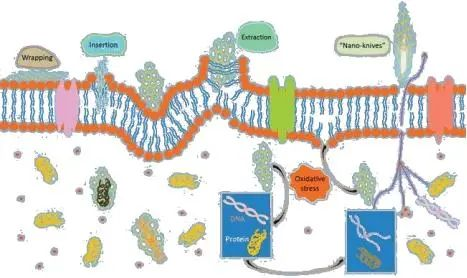Scientific research has found that graphene has a strong killing effect on bacteria, and it has a broad space for both clinical and commercial applications. Since nano-scale graphene is connected into a series of carbon atoms like a very thin and dense cloth, graphene antibacterial additives mainly play a bactericidal role in the following three ways:
1. Physical cutting effect
After the bacteria are in direct contact with the graphene-based material, the sharp sheet of the material pierces the bacterial cell membrane, causing the outflow of the cell contents and killing the bacteria;
2. Oxidative stress
After the cell membrane is in direct contact with the graphene-based material, the free radical reaction is stimulated through the transfer of charges or the generation of ROS, thereby destroying the membrane structure of bacteria and important biological macromolecules and dying;
3. Destroy lipid molecules
Graphene nanosheets can be inserted into the bacterial cell membrane in a short period of time to extract the phospholipid components, or spread directly on the surface of the cell membrane to trigger the flipping of lipid molecules, eventually leading to the lysis and death of the bacteria.

Graphene antibacterial additive antibacterial principle diagram
As a common chemical, the main functions of silver ions are antibacterial, deodorizing, antiseptic, and water purification. It is suitable for anti-inflammatory and sterilization in medical treatment, and promotes wound healing. At present, the most widely used antibacterial products are silver ion antibacterial agents. The principle of action is as follows:
1. Interfering with the synthesis of cell walls
The important component of bacterial cell wall is peptidoglycan, and the interference effect of silver ion antibacterial agent on the cell wall mainly inhibits the polysaccharide chain and tetrapeptide cross-linking, so that the cell wall loses its integrity, loses its protection against osmotic pressure, and damages the bacterial cell wall. body to achieve a bactericidal effect;
2. Can damage the cell membrane
Silver ions can damage the cell membrane, an important part of bacterial cell life activities. Therefore, if the cell membrane is damaged or destroyed, the bacteria will die;
3. Inhibition of protein synthesis
Under the action of silver ions, the protein synthesis process of bacteria changes, stops, and causes the bacteria to die. Interfering with the synthesis of nucleic acids hinders the replication of genetic information, including the synthesis of DNA and RNA, and the transcription of mRNA from DNA templates.